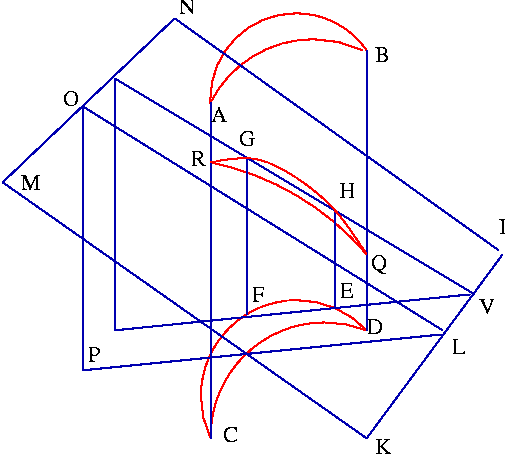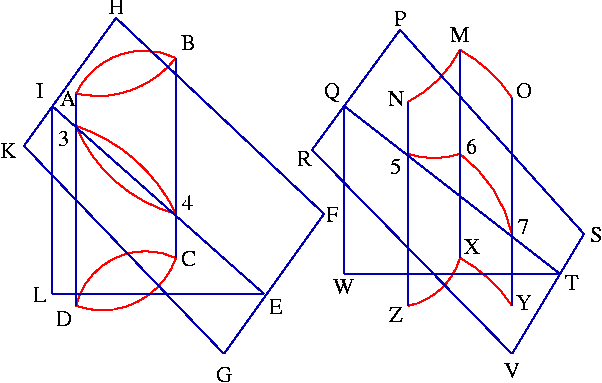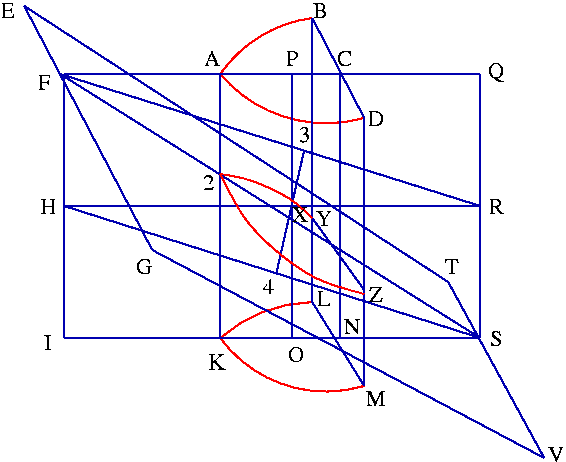- About MAA
- Membership
- MAA Publications
- Periodicals
- Blogs
- MAA Book Series
- MAA Press (an imprint of the AMS)
- MAA Notes
- MAA Reviews
- Mathematical Communication
- Information for Libraries
- Author Resources
- Advertise with MAA
- Meetings
- Competitions
- Programs
- Communities
- MAA Sections
- SIGMAA
- MAA Connect
- Students
- MAA Awards
- Awards Booklets
- Writing Awards
- Teaching Awards
- Service Awards
- Research Awards
- Lecture Awards
- Putnam Competition Individual and Team Winners
- D. E. Shaw Group AMC 8 Awards & Certificates
- Maryam Mirzakhani AMC 10 A Awards & Certificates
- Two Sigma AMC 10 B Awards & Certificates
- Jane Street AMC 12 A Awards & Certificates
- Akamai AMC 12 B Awards & Certificates
- High School Teachers
- News
You are here
James Gregory and the Pappus-Guldin Theorem - Selections from the GPU (1)
James Gregory's Proof of the Pappus-Guldin Theorem is given in Proposition 35 of the GPU, but the groundwork for Gregory's proof is carried out in a series of propositions prior to that. A translation of the complete work is available online here. The necessary propositions (Propositions 23,27, 29, 31, 33, and 35) are largely self-contained and translations are included here for completeness. Latin originals of these propositions are given in the next section.
Proposition Twenty-three.
If a right cylindrical figure above a given figure is cut by a plane, the trunk of this cylindrical figure will be to the solid of revolution arising from the rotation of its base around the common intersection of the extended (if necessary) base and the cutting plane as the altitude of the cylindrical figure is to the circumference of the circle whose radius is the radius of rotation.
Let ABDC be a right cylindrical figure above a figure DCF which is cut by a plane KINM in such a way that the figure RGHQ is the common intersection of the plane with the cylinder.

Let the cutting plane be extended until it cuts the base plane DCF in the line KI and the plane of AB in the line MN. From any point, say, L, on the line IK let a plane OLP be drawn perpendicular to IK and cutting the planes IKMN and DFC normally in the lines OL and LP. Let the line OP be perpendicular to LP. We assume that KI is the axis of rotation. We call the line PL normal to this the radius of rotation. I say that the trunk RQDC of the cylinder is to the solid of revolution arising from the rotation of the figure DEFC around the axis of rotation IK as the altitude OP of the cylinder is to the circumference of the circle whose radius is the radius of rotation LP.
Let EF be any line terminated on both sides of the circumference of the base at E and F and drawn through the base DEFC, which, when extended, intersects the axis of rotation normally in the point V. From the points E and F let EH and FG be sent out perpendicular to the base plane and terminated in the cutting plane at H and G. Since the cylinder is right, these are necessarily on the surface of the trunk. Let the line VH be drawn, which is necessarily in the cutting plane IKMN. It is manifest that the triangles OLP and HVE, which have right angles at the points P and E, are similar (since the angles OLP and HVE are equal to the inclination of the cutting plane IKMN). With the line GV having been drawn, the triangles HEV and GFV are similar for the same reason. Since GF is parallel to the line HE and EF intersects EV, the lines GV and HV lie on one line in the plane IKMN. GHEF will be the common intersection of the plane GFV, parallel to the plane OPL, with the truncated cylinder RQDC. Therefore, it is apparent that OP is to PL as HE is to EV. Therefore, as OP is to the circumference of the circle whose radius is PL, thus HE is to the circumference of the circle whose radius is EV. And as OP is to the circumference of the circle whose radius is PL thus the triangle HEV is to the circle whose radius is EV (by drawing the remaining boundaries to the same altitude, namely, half of the line EV). It is demonstrated in the same manner that as OP is to the circumference of the circle whose radius is PL, thus the triangle GFV is to the circle whose radius is FV. Therefore, the entire triangle GFV is to the entire circle with radius FV thus as the cut-off triangle HEV is to the cut-off circle whose radius is EV. Consequently, the remaining trapezoid GFEH will be in the same ratio to the remaining annulus arising from the revolution of the line FE around the axis of rotation IK, namely, in the ratio of OP to the circumference of the circle whose radius is LP. But this proportion is demonstrated in the same manner for all lines drawn in the base DEFC which, when extended (if necessary), meet the axis of rotation IK normally. But the base DC consists of all such lines, the trunk RQDC consists of all of the trapezoids above these lines, and the solid of revolution arising from the revolution of the base around the axis of revolution IK consists of all of the annuli produced by the revolution of these lines. Consequently, as one antecedent is to one consequent -- namely, the altitude OP of the cylinder is to the circumference of the circle whose radius PL is the radius of rotation -- thus, all antecedents -- namely, all trapezoids -- that is, the trunk RQDC -- are to all consequents -- namely, all annuli -- that is, the solid of revolution arising from the rotation of the figure DC around the axis IK, which it was desired to demonstrate.
This theorem is demonstrated in the same manner for the upper trunk if the figure AB is conceived to be rotated around the line MN.
It is apparent from the demonstration that the trunk RQDC and the solid of revolution arising from the revolution of the base DC around the axis of rotation IK are proportional quantities in magnitude and weight, since each proportion which is demonstrated among the entireties is demonstrated in the same manner concerning their proportional parts.
In the following results it ought to be noted that (when we speak about the surface of the cylindrical figure or of the trunk) we understand a surface alone without bases. That is, we never consider figures which are the base of the cylinder, nor do we consider the common intersection of the plane cutting the cylinder.
Proposition Twenty-seven.
If two given right cylindrical figures of equal height are both cut by a plane into two trunks, the proportion of the solid of revolution arising from the rotation of the base of the cylinder around the common intersection of the extended (if necessary) base with the cutting plane to the solid of revolution arising from the same rotation of the base of the other cylinder is compounded directly from the proportion of the radii of rotation and the proportion of the lower trunks of the cylinder.
Let ABCD and NMOYXZ be two right cylindrical figures of equal height with bases DC and XYZ which are cut by planes together into two trunks. Specifically, let ABCD be cut by the plane KHFG into trunks AB43 and 43DC and let NMOYXZ be cut by a plane PSVR into trunks NMO765 and 765ZXY. Let the lines KH and GF be the intersections of the plane HFGK with the planes of the extended (if necessary) parallel bases DC and AB of the cylinder, and let the lines RP and VS be the intersections of the plane RVSR with the planes of the extended (if necessary) parallel bases NMO and ZXY of the cylinders. Let there be planes normal to the lines FG and SV which intersect the cutting planes in the lines IE and QT and the planes of the extended (if necessary) DC and ZXY bases in the lines LE and WT, and let the angles ILE and QWT be right.

It is manifest from Proposition 23, with HFGK and PSVR the assumed cutting planes and GF and VS the axes of rotation, that LE and WT are the radii of rotation. Therefore, I say that the solid of revolution arising from the rotation of the figure DC around GF is to the solid of revolution arising from the rotation of the figure ZXY around VS in the ratio compounded from the proportion of the trunk 34CD to the trunk 567YXZ and from the proportion of the radius of rotation LE to the radius of rotation WT.
The ratio of the solid of revolution arising from the figure DC to the solid of revolution arising from the figure ZXY is compounded from the ratio of the solid of revolution arising from DC to the trunk 34CD, from the ratio of the trunk 34CD to the trunk 567YXZ, and from the ratio of the trunk 567YXZ to the solid of revolution arising from YXZ. But the ratio of the solid of revolution arising from DC to the trunk 34CD is equal to the ratio of the circumference of the circle described by the radius LE to the altitude IL of the cylinder. (See Proposition 23.) The ratio of the trunk 567YXZ to the solid of revolution arising from YXZ is equal to the ratio of the altitude QW -- that is, IL -- of the cylinder to the circumference of the circle described by the radius TW. Consequently, the ratio of the solid of revolution arising from DC to the solid of revolution arising from ZXY is compounded of the ratio of the trunk 34CD to the trunk 567YXZ, from the ratio of the circumference of the circle described by the radius LE to the line IL, and from the ratio of the line IL to the circumference of the circle described by the radius TW. But these last two ratios compound to the ratio of the circumference described by the radius LE to the circumference of the circle described by the radius TW, which is the same as the ratio of the radius LE to the radius TW. Consequently, the solid of revolution arising from the rotation of the figure DC around the axes FG is to the solid of revolution arising from the rotation of the figure XYZ around the axis VS in a ratio compounded from the proportion of the lower trunk 34CD to the lower trunk 567YXZ and from the proportion of the radius of rotation EL to the radius of rotation TW, which ought to have been demonstrated.
Proposition Twenty-nine.
If a right cylindrical figure above a figure symmetric around an axis is envisioned which is cut by a plane into two trunks such that a plane drawn through the axes on opposite bases of the cylinder is normal to that cutting plane, then one trunk will be to the other trunk as the reciprocal of the parts of the radius of rotation having been cut by the center of gravity of the figure.
Let the right cylinder ABDMLK above a figure KLM symmetric around the axis KN be cut into trunks ABDZY2 and ZY2KLM by a plane ETVG normal to the plane ACNK drawn through the axes AC and KN of the opposite bases of the cylinder. Let P and O, which are joined by a line PO, be the centers of gravity of the opposite bases. Let the cutting plane be extended until it intersects the extended (if necessary) axes AC and KN in the points F and S. Let FI and SQ be perpendiculars to those same extended (if necessary) axes. It is manifest that FISQ is a rectangular parallelogram, also that FI is an altitude of the cylinder, and that IS is a radius of rotation which is certainly perpendicular to the intersection of the cutting plane and the base LKM -- that is, to the line TV -- since it is drawn in the plane FQSI, which is normal to both the cutting plane and the base LKM. I say that the trunk ABDZY2 is to the trunk 2YZMLK as the reciprocal of the ratio of IO to OS.
From the midpoints of the lines FI and QS -- namely, H and R -- let the lines HS, RF, and HR be drawn, with HR cutting OP in X. Thus FI, PO, and QS; and likewise FQ, HR, and IS; and likewise FR and HS will be parallel and equal among themselves. Since FR bisects QS, it will also bisect all the lines in the triangle FQS equidistant to QS itself. Consequently, it will bisect all the diameters of the rectangles in the trunk ABDZY2 which are cut normally by the plane FISQ. Therefore, it will pass through the centers of gravity of all of those rectangles.

Since the trunk consists of all of those rectangles, the line FR will pass through the center of gravity of the trunk. Suppose this point is 3. It is demonstrated in the same manner that the center of gravity of the trunk YZMLK2 is on the line HS. Therefore, since the midpoint X of the line OP is the center of gravity of the entire cylinder, if the line 3X4 is drawn through X from 3 until it intersects the line HS in 4, 4 will be the center of gravity of the trunk YZMLK2. Because the triangles XR3 and XH4 are similar on account of RF and HS being parallel, as X4 is to X3 thus XH will be to XR -- that is, IO will be to OS. But as X4 is to X3 thus the trunk ABDZY2 will be to the trunk ZYMKL2. Consequently, as the trunk ABDZY2 is to the trunk YZKMK2 thus IO will be reciprocally to OS, which ought to have been demonstrated.
Consequence.
Consequently, by componendo the entire cylinder ABDMLK is to the lower trunk YZMLK2 as the radius of rotation IS is to the distance between the center of gravity of the original figure and axis of rotation of the original figure--namely, OS.
Andrew Leahy (Knox College), "James Gregory and the Pappus-Guldin Theorem - Selections from the GPU (1)," Convergence (February 2010), DOI:10.4169/loci003262




